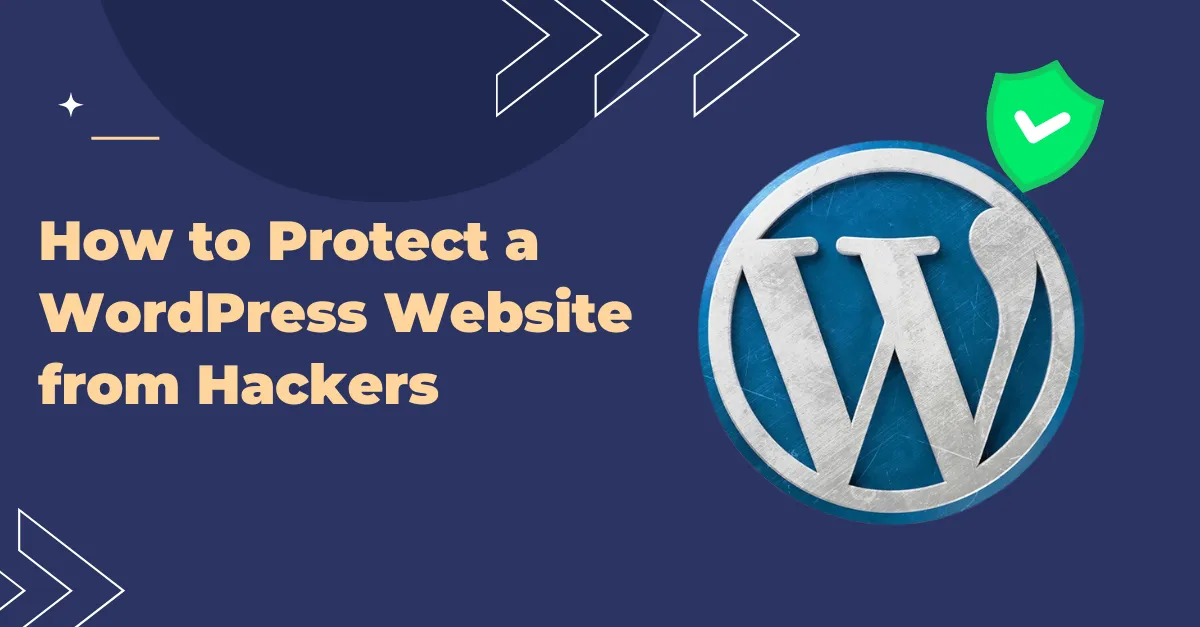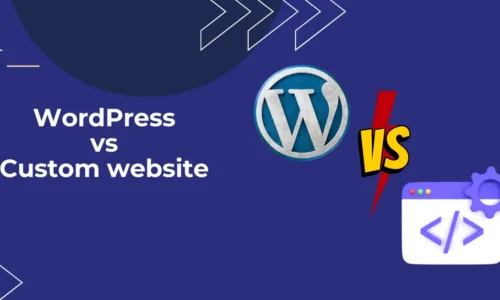How to Protect a WordPress Website from Hackers?7 min read
- dhiraj
- 07/10/2023
- Web Designing
- 0 Comments

As a WordPress website owner, ensuring the security of your website should be a top priority. With the growing number of cyber threats and hacking attempts targeting WordPress sites, it’s crucial to take proactive measures to protect your website and its valuable information. This blog post will explore practical strategies to safeguard your WordPress website from hackers. From implementing solid passwords to keeping your WordPress installation up to date, we will cover everything you need to know to fortify your website’s defenses.
WordPress is one of the most popular content management systems (CMS) worldwide. Its user-friendly interface, extensive plugin library, and customizable themes make it a go-to platform for individuals and businesses. However, its widespread use has also become a target for hackers looking to exploit vulnerabilities and gain unauthorized website access. But fear not; following a few best practices and implementing security measures can significantly reduce the risk of your WordPress site falling victim to cyber-attacks.
So, Before Jumping to the solutions, Let’s first discuss the main reasons for website hacking.
What are the main reasons for website hacking?
Weak Passwords
One of the primary reasons why WordPress websites fall victim to hacking is through weak passwords. As the first line of defense, passwords are crucial in securing sensitive information. However, many website owners need to pay more attention to the importance of a strong password, opting for simple and easily guessable combinations. Hackers use sophisticated algorithms and dictionary attacks to decipher passwords, making weak passwords vulnerable to breaches.
Outdated Software
Another common reason behind WordPress website hacking is the use of outdated software versions. WordPress frequently releases updates to enhance security, fix bugs, and introduce new features. Ignoring these updates exposes websites to known vulnerabilities that hackers exploit to gain unauthorized access.
To prevent your WordPress website from becoming an easy target, regularly update WordPress core files, themes, and plugins. By updating to the latest versions, you benefit from security patches that address known vulnerabilities, making it significantly harder for hackers to exploit weaknesses within your website’s software.
Vulnerable Plugins and Themes
While plugins and themes add functionality and aesthetic appeal to WordPress websites, they can also present opportunities for hackers. Poorly coded or outdated plugins and themes often contain vulnerabilities malicious actors can exploit. These vulnerabilities may allow hackers to inject malicious code, gain unauthorized access, or even take control of the entire website.
Regularly updating the latest versions is crucial to minimize the risk of your WordPress website being hacked through vulnerable plugins and themes. Additionally, consider removing any unnecessary plugins or themes you no longer use, as they can pose potential security threats.
Insecure Hosting
The hosting provider you choose for your WordPress website can significantly impact its security. Opting for an insecure hosting service or one with poor security measures exposes your website to potential vulnerabilities. This can include weak server configurations, insufficient firewall protection, or outdated software running on the hosting environment.
Ensure you choose a reputable and reliable hosting provider specializing in WordPress hosting. Look for features such as robust firewalls, regular security audits, malware scanning, and automatic backups. Investing in secure hosting protects your website from hacking attempts and provides peace of mind, knowing that your valuable data is in good hands. You Can go with some good. You can check out some excellent hosting companies such as Hostinger, Bluehost, and Siteground.
Human Error
Even with the best security measures, human error remains an often overlooked factor that can lead to WordPress website hacking. Whether unintentionally granting excessive user privileges, falling victim to phishing attacks, or misconfiguring security settings, human errors can create unintended vulnerabilities for hackers to exploit.
To mitigate the risk of human error, educating yourself and your team about best practices for website security is crucial.
How Can You Secure your WordPress Website from Hackers?
You can secure your website by following these steps.
1. Set Strong and Unique Passwords
Setting solid and unique passwords is one of the most straightforward yet essential steps to protect your WordPress website. Avoid common passwords like “password123” or “admin” that are a piece of cake for hackers to crack. Instead, use a combination of letters, numbers, and special characters. Consider using a password manager tool to generate and securely store your passwords. This ensures complexity and helps you avoid using the same password across multiple platforms.
2. Keep Your WordPress Installation Up to Date
Regularly updating your WordPress installation is crucial in safeguarding your website. WordPress frequently releases updates to address security vulnerabilities and improve the overall performance and functionality of the CMS.
By keeping your WordPress core, themes, and plugins up to date, you ensure that known security flaws are patched and hackers have a more challenging time finding loopholes to exploit.
3. Install Security Plugins
WordPress offers a wide range of security plugins that can significantly enhance the protection of your website. These plugins add extra layers of security and monitor your site for any suspicious activity.
Popular security plugins like Wordfence, Sucuri, and iThemes Security provide malware scanning, firewall protection, two-factor authentication, and login lockdown features. Installing and configuring a reputable security plugin can significantly reduce the risk of your WordPress site being hacked.
4. Limit Login Attempts
Brute-force attacks, where hackers attempt to gain access to your website by repeatedly guessing usernames and passwords, are standard hacking techniques. To mitigate the risk of such attacks, you can limit the number of login attempts on your WordPress site.
By implementing a plugin like Limit Login Attempts Reloaded, you can set a threshold for failed login attempts and automatically lock out IP addresses that exceed the limit. This prevents hackers from continuously guessing passwords and increases the security of your website.
5. Disable File Editing
WordPress allows administrators to edit theme and plugin files directly from the dashboard by default. While this may be convenient, it can also pose a security risk. If a hacker gains unauthorized access to your WordPress admin panel, they can inject malicious code into these files, compromising your website’s security.
To prevent this, you can turn off file editing by adding a simple line of code to your site’s wp-config.php file. This prevents hackers from modifying your theme and plugin files even if they can access your admin panel.
6. Implement Two-Factor Authentication (2FA)
Two-factor authentication (2FA) adds an extra layer of security to your WordPress login process. With 2FA enabled users must provide a second form of authentication, usually a one-time password or a verification code sent to their mobile device, in addition to their regular username and password.
This makes it significantly harder for hackers to gain unauthorized access to your website, as they need access to both your login credentials and the secondary authentication method. You can easily set up 2FA on your WordPress site using plugins like Google Authenticator or Authy.
7. Regularly Back Up Your Website
No matter how many security measures you implement, there is always a small risk of a breach. To ensure that your website can be quickly restored during an attack or data loss, it’s essential to back up your WordPress site regularly.
Implement a robust backup strategy, including the database and your website files. You can use plugins like UpdraftPlus or BackupBuddy to automate the backup process and store the backups in remote locations like cloud storage services or an external server.
8. Change Login Url:
One of the best ways to Secure your WordPress website is by changing the default login URL to Something else. For example, the default URL to log on to WordPress is yourdomain.com/wp-login/, But most hackers can access this page. So, in this case, you can change your login URL to Yourdomain.com/test. or anything you prefer.
Conclusion
Securing your WordPress website is an ongoing process that requires constant vigilance and proactive measures. By following the strategies outlined in this blog post, such as setting strong passwords, keeping your WordPress installation up to date, installing security plugins, and implementing additional security measures like 2FA, you can significantly enhance the security of your website and protect it from potential hackers.
Remember, the key to website security is staying informed about the latest security best practices and regularly updating your security measures. With a strong security foundation in place, you can focus on growing your business without constantly worrying about the safety of your WordPress website. Stay safe, stay secure!





